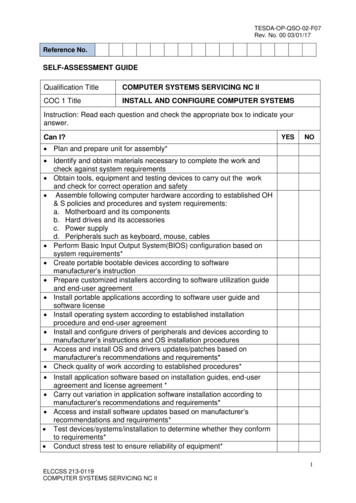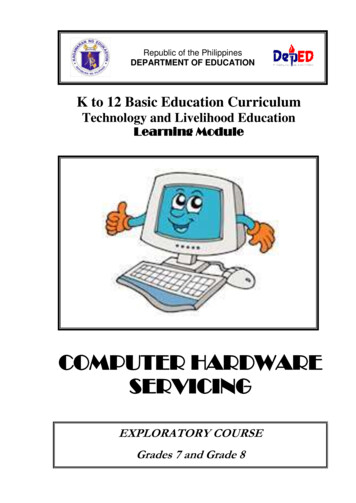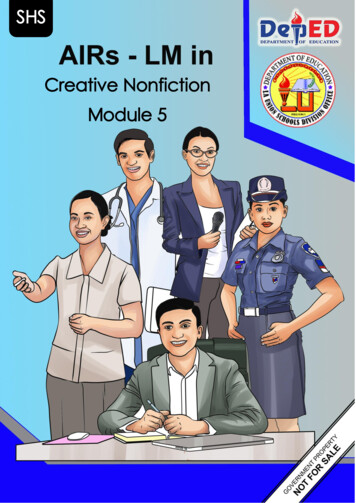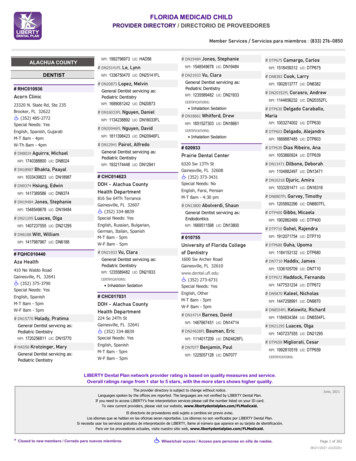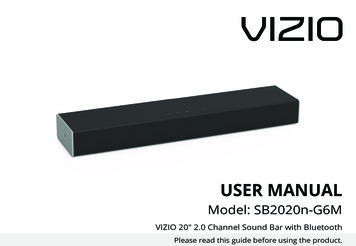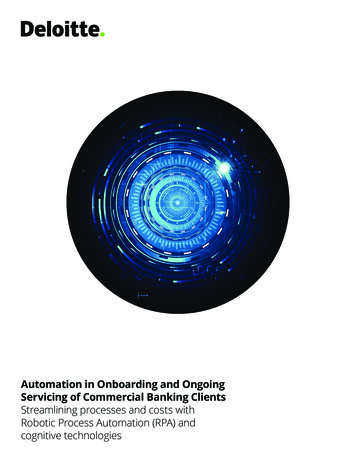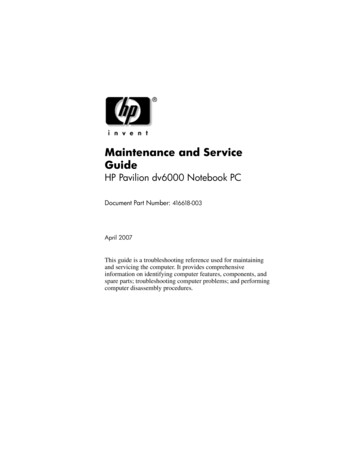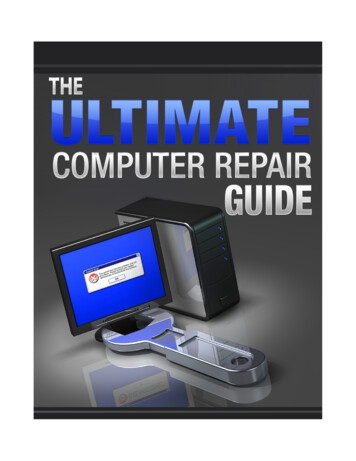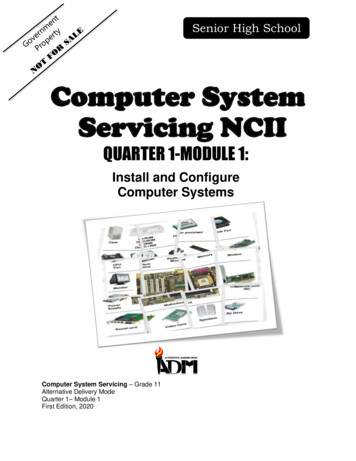
Transcription
Senior High SchoolComputer SystemServicing NCIIQUARTER 1-MODULE 1:Install and ConfigureComputer SystemsComputer System Servicing – Grade 11Alternative Delivery ModeQuarter 1– Module 1First Edition, 2020
Republic Act 8293, section 176 states that: No copyright shall subsist in any work of theGovernment of the Philippines. However, prior approval of the government agency or officewherein the work is created shall be necessary for exploitation of such work for profit. Suchagency or office may, among other things, impose as a condition the payment of royalties.Borrowed materials (i.e., songs, poems, pictures, photos, brand names, trademarks, etc.)included in this book are owned by their respective copyright holders. Every effort has beenexerted to locate and seek permission to use these materials from their respective copyrightowners. The publisher and authors do not represent nor claim ownership over them.Published by the Department of EducationSecretary:Leonor M. BrionesUndersecretary:Assistant Secretary:Development Team of the ModuleWriter:Content Editor:Language Editor:Proof-reader:Illustrator:Lay-out Artist:Manny P. DaleonCherry Q. Sadicon; Fe L. Dalugdug; Shiela T. ArellanoCleo C. CanonceMarsha Liza L. RagotJoanne A. ComahigNorman D. BalinoManagement Team:Chairperson:Dr. Arturo B. Bayocot, CESO IIIRegional DirectorCo-Chairperson:Dr. Victor G. De Gracia Jr. CESO VAsst. RegionalJonathan S. dela Peña, PhD, CESO VSchools Division SuperintendentRowena H. Para-on, PhDAssistant Schools Division SuperintendentMala Epra B. Magnaong, Chief ES, CLMDMembers:Neil A. Improgo, PhD, EPS-LRMS;Bienvenido U. Tagolimot, Jr., PhD, EPS-ADM;Erlinda G. Dael, PhD, CID Chief;Norberto E. Rosales, EPS (TLE-TVL) In-charge;Celieto B. Magsayo, LRMS Manager;Loucile L. Paclar, Librarian II;Printed in the Philippines byDepartment of Education – Bureau of Learning Resources (DepEd-BLR)Office Address:Zone 1, Upper Balulang Cagayan de Oro City 9000Telefax:(088) 880-7071, (088) 880-7072E-mail Address:region10@deped.gov.phDepartment of Education Republic of the Philippines
Senior High SchoolComputer SystemServicing NCIIMODULE 1:Install and ConfigureComputer SystemsThis instructional material was collaboratively developed andreviewed by educators from public and private schools, colleges, and/oruniversities.We encourage teachers and other education stakeholders to emailtheir feedback, comments, and recommendations to the Department ofEducation at action@deped.gov.phWe value your feedback and recommendations.Department of Education Republic of the Philippines
Table of Contents . . 1General Instructions 1Module Objectives 2Module Content 2What I Know 2What I Need To KnowQuarter 1Learning Outcome 1 Assemble computer hardwareSelf-Scheck 1Task Sheet 1Learning Outcome 2. Prepare InstallerSelf-Scheck 2Task Sheet 2Quarter 2Learning Outcome 3. Install operating system and driversfor peripherals/ devicesSelf-Scheck 3Task Sheet 3Learning Outcome 4. Install application softwareSelf-Scheck 4Task Sheet 4Learning Outcome 5. Conduct testing and documentationSelf-Scheck 5Task Sheet 5Post-Test 70Key to Answers 76References 79
TO THE STUDENTGreetings!This module contains training materials and activities for you to finish. You arerequired to go through a series of learning activities. If you have questions, don’thesitate to ask your teacher for assistance.This will give you the opportunity to develop your knowledge, hone your skills,behavior and motivations required in Installing and Configuring Computer Systemsthat is in line with the industry standards. You need to complete this module beforeyou can perform the next module.HOW TO USE THIS MODULEThe unit of competency, “Install and Configure Computer Systems“, is one of thecompetencies of Computer Systems Servicing NCII, a course which comprisesknowledge, skills and attitudes required for a trainee to possess.In this module, you are required to go through a series of learning activities in orderto complete each learning outcome. In each learning outcome are Information Sheets,Self-Checks, Operation Sheets and Task/Job Sheets. Follow and perform the activitieson your own. If you have questions, do not hesitate to ask for assistance from yourteacher.Remember to:1. Work through all the information and complete the activities in each section.2. Read information sheets and complete the self-check. Suggested references areincluded to supplement the materials provided in this module.3. Most probably, your trainer will also be your supervisor or manager. He is there tosupport you and show you the correct way to do things.4. You will be given plenty of opportunities to ask questions and practice on the job.Make sure you practice your new skills during regular work shifts. This way, youwill improve your speed, memory and your confidence.
IntroductionThis module is designed to equip you the TVL Open High School Learners withessential Knowledge, Skills, and Attitude in performing the tasks on Computer SystemServicing which will lead you to acquire National Certificate Level II.This module includes information and activities to develop desirable values, skillsand understanding through step-by-step procedures and helpful techniques that will guideyou on how to install and configure computer systems. Furthermore, applications to reallife situations are also included for lifelong learning.What to Learn in this Module?At the end of the lesson, you’re expected to:1.2.3.4.5.Assemble computer hardware.Prepare installer.Install operating system and driver for peripherals/devices.Install application software.Conduct test and documentation.1
Pre-TestWhat I Know?1. What does BIOS stand for?a.b.c.d.Basic input output systemBasic induct online systemBasic industry online standardsBasic insulator open source2. CPU is the of the computer.a.b.c.d.mothersystembrainprocess3. What cable is used to connect PC to switch hub and router?a.b.c.d.UTP cablestraight thru cablecross over cablecopper cable4. Is the hardware in a computing device where the operating system (OS), applicationprograms and data in current use are kept so they can be quickly reached by thedevice's processor.a.b.c.d.RAMOperating systemCPUHDD5. What RAM stands for?a.b.c.d.Random Access MemoryRandom Autonomous MemoryRead Action MemoryRare Ally Memory2
6. Identify the malwares.a. trojanb. virusc. spywared. all of the choices7. An example of super computer is :a. MP3 playersb. Desktopc. Cell phonesd. Mainframe computers8. ROM isa. random access memory - temporaryb. random access memory - permanentc. read only memory - temporaryd. read only memory – permanent9. An example of a software :a. USBb. Printerc. Exceld. Keyboard10. USB stands fora. Universal Serial Busb. University Serial Busc. Universal Serial Bodyd. Universal Series Bus11. What is this?a. Mouseb. Speakersc. Keyboardd. MonitorCommons.wikimedia.org12. What is this?a. CPUb. Modemc. Internetd. CableCommons.wikimedia.org3
13. What is this?a. Malwareb. Softwarec. Hardwared. People14. OS stands fora. Onsite Softwareb. Operating Systemc. Only Read Softwared. On-demand SystemCommons.wikimedia.org15. What is this?a. CPUb. Processorc. System Unitd, PCCommons.wikimedia.org4
Definition of TermsCPU-Central processing unit; the brain of the computer; controls the other elementsof the computerDisk Drive-A peripheral device that reads and/or writes information on a diskHard Drive-A device (usually within the computer case) that reads and writesinformation, including the operating system, program files, and data filesKeyboard-A peripheral used to input data by pressing keysModem-A peripheral device used to connect one computer to another over a phonelineMonitor-A device used to display information visuallyMouse-A peripheral device used to point to items on a monitorPrinter-A peripheral device that converts output from a computer into a printed imageBrowser-A program used to view World Wide Web pages, such as NetscapeNavigator or Internet ExplorerDriver-Software program that controls a piece of hardware or a peripheralIcon-A small picture used to represent a file or program in a GUI interfaceInternet-A network of computer networks encompassing the World Wide Web, FTP,telnet, and many other protocolsURL-Uniform resource locator; the address of a site on the World Wide Web; astandard way of locating objects on the InternetVirus-A deliberately harmful computer program designed to create annoying glitches ordestroy dataWindow-A screen in a software program that permits the user to view several programsat one time5
What I Need To Know?Read Information Sheet No 1.1-1 and find out how much you canremember. Do Self-Check 1.1-1 to know how much you have learned.Lesson Information 1.1-1OCCUPATIONAL HEALTH AND SAFETY POLICIES AND PROCEDURESLearning Objectives:After reading of this Information Sheet, you should be able to:1. Identify the basic precautions and procedures in planning, preparing, installing andtesting of computer hardware and software.2. Determine the effects of computers to the people, health risk, and to the environment.During installation and initial test, careful planning and preparation are to be done.To avoid personal injury and damages to wiring due to sharp pins on connectors andprinted circuit assemblies, rough chassis edges and corners, and hot components.Adhere to warnings and limitations regarding accessibility into areas designatedonly for authorized technical personnel.SOME BASIC PRECAUTIONS AND PROCEDURES:o Before starting the installation, read carefully the documentation and procedureson any hardware and software settings that may be required.o Failure to do the proper jumper setting may cause damage to your CPU.o Without an effective cooling fan, the CPU can overheat and cause damage to bothCPU and the motherboard.o Each bank must have the same size and type of memory installed in pairs.o Before adding and removing any other system components, make sure that youunplug your power supply. Failure to do so may cause damage to yourmotherboard and in the system component.6
o Test the computer, ensuring that it meets the necessary system requirementsbefore booting up.o If the computer does not pass any of the power on self-test (POST), the computerwill receive an irregular power on self-test. An irregular POSTis a beep codewhich is different from the standard beep which can either be no beeps at all or acombination of different beeps.EFFECTS OF COMPUTERSSome effects of computers relating to the violation of privacy, the impact on thelabor force, health risks, and the impact on the environment.1. Violation of PrivacyNearly every life event is stored in a computer somewhere--in medical records,credit reports, tax records, etc. It is crucial that personal and confidential records beprotected properly. In many instances, where these records were not properlyprotected, individuals have found their privacy violated and identities stolen.2. Impact on Labor ForceAlthough computers have improved productivity in many ways and created anentire industry with hundreds of thousands of new jobs, the skills of millions of workersand managers have been replaced by computers. Thus, it is crucial that workers keeptheir education up-to-date. A separate impact on the labor force is that some companiesare outsourcing jobs to foreign countries instead of keeping their homeland labor forceemployed.3. Health RisksProlonged or improper computer use can lead to injuries or disorders of the hands,wrists, elbows, eyes, necks, and back. Computer users can protect themselves fromthese health risks through proper workplace design, good posture while at the computer,7
and appropriately spaced work breaks. Another health risk, called computer addiction,occurs when someone becomes obsessed with using the computer. Once recognized,computer addiction is a treatable disorder.4. Public SafetyAdults, teen, and children around the world are using computers to share publiclytheir photos, videos, journals, music, and other personal information. Some of theseunsuspecting, innocent computer users have fallen victim to crimes committed bydangerous strangers. Protect yourself and your dependents from these criminals by beingcautious. For example, do not share information that would allow others to identify orlocate you.5. Impact on EnvironmentComputer manufacturing processes and computer waste are depleting naturalresources and polluting the environment. The amount of resources required tomanufacture a personal computer equals that of a mid-sized car. When computers arediscarded in landfills, they release toxic materials and potentially dangerous levels oflead, mercury, and flame retardants. Strategies that can help protect the environmentinclude recycling, regulating manufacturing processes, extending the life of computers,and immediately donating replaced computers.8
SELF-CHECK NO. 1.1-1A. IDENTFICATIONDirection:Identify the Precautions and Procedures write TRUE if the statementis correct and FALSE if the statement is wrong.1. Failure to do the proper jumper setting may cause damage to your CPU.2. After adding and removing any other system components, make sure thatyou unplug your power supply.3. Test the computer, ensuring that it meets the necessary systemrequirements before booting up.4. With an effective cooling fan, the CPU can overheat and cause damage toboth CPU and the motherboard.5. After starting the installation, read carefully the documentation andprocedures on any hardware and software settings that may be required.B. MATCHING TYPEDirection: Select your answer on the choices below that will correspond on thestatement. Write the letter of your answer on the space provided.A.B.C.D.E.Violation of PrivacyImpact on the EnvironmentPublic SafetyHealth RiskImpact on Labor Force1. Computer manufacturing processes and computer waste are depletingnatural resources and polluting the environment.2. Although computers have improved productivity in many ways andcreated an entire industry with hundreds of thousands of new jobs, theskills of millions of workers and managers have been replaced bycomputers.3. It is crucial that personal and confidential records be protected properly.4. Adults, teen, and children around the world are using computers to sharepublicly their photos, videos, journals, music, and other personalinformation.5. Prolonged or improper computer use can lead to injuries or disorders ofthe hands, wrists, elbows, eyes, necks, and back.9
What I Need To Know?F. Information Sheet No 1.1-2 and find out how much you canReadG.remember.Do Self-Check 1.1-2 to know how much you have learned.H.Lesson Information 1.1-2LEARNING OBJECTIVES:After reading this Information Sheet, you should be able to:1. Prepare the required documents or forms before you do a well-planned installation2. Identify the qualifications to be a certified hardware professional so that you couldbe allowed and authorized to do a well-planned installationREQUIRED DOCUMENTS/FORMSA. Job Order- (sometimes job ticket or work ticket, as it often has some type of ticketattached) is an order received by an organization from a customer or client, or anorder created internally within the organization. A work order may be for products orservices.o the quantity of the product to be manufactured, built or fabricatedo the amount of raw material to be used, its price and amounto the types of labor required, rate (per hour or per unit) and amounto the machine utilization for each machine during the routing process, its rateand amount10
Sample Job Order FormComputer Repair Job Order FormTeacher Client’s NameSchool Alubijid NCHSDate July 27, 2020Computer # 001Service Tag# 001Model Intel i3Serial # 4737ZComputer Problem: (Brief Description of the Problem)***Blue Screen Error***For Technical Department Used OnlyFax No. (02)922-5566Computer Fixed By: Alexis V. LarosaDate Sent Back to School:Memory Transcend 2 GHzHard Drive Space Hitachi Sata 80 GigProcessor Pentium Dual-Core 2 GHzWindows Windows 7 UltimateB. Request Form and Report SheetComputer Hardware Servicing maintenance, which includes planned installation,main objective is to keep and improve production facilities, to keep and improveproduction facilities stable and efficient at the lowest life cycle cost with the activeparticipation of all members in the company. A Request Form is used to put thisobjective into action. And the Report Sheet and Request Form bring to life thismaintenance’s purposes which are:o To increase productivity through maximum utilization and improvement of allequipmento To develop maintenance system to reduce life cycle cost of machinery andequipment through the involvement of everybody in the organizationo To develop the operator’s capability to be competent in maintenance activitiesthrough education, training and motivation.o To enhance capability for advanced and sophisticated technology that wouldreinforce competitive power.11
Sample Request FormDescription: Acer Aspire 4736Z Laptop ComputerUNIT NO. 5-2Observation/s:***Corrupted Operating System***Date Reported:January 1, 2020Reported by:Alexis V. LarosaActivity: Reformat LaptopDate Completed: July 27, 2020Signed:Sample Report SheetRepair Report SheetArea/Section: ANCHS Computer LaboratoryFacility TypeNature of BreakdownRecommendationLaptop No OperatingViral CorruptionRefer to the TechnicalDepartment forReformatting of theOperating SystemSystem ErrorReported by: Marybel A. GuinitaranDate: March 27, 202012
REQUIRED QUALIFICATION FOR A COMPUTER HARDWARE PERSONNEL:What Qualifications Do You Need to Become a PC Repair Technician?EducationEmployers prefer applicants who have completed and pass the NationalCertification Exam II (NC II) from any DepEd School, vocational training institute or similarsetting. Some employers require at least a high school diploma.CertificationsTrainees can take the TESDA NC II Computer System Servicing assessment todemonstrate their competency for entry-level jobs to employers. The Technical Educationand Skills Development Authority or TESDA offers a variety of certification programs. Inaddition, technicians can achieve certifications even for trainer ship.Physical and Personal TraitsPC technicians must be able to squat, bend and reach to access the computerequipment requiring repair. They should be physically able to lift computer components.Employers want technicians who think analytically, are organized and pay attention todetail. They should feel comfortable working under tight deadlines, and companies mayexpect them to work overtime or on weekends.Knowledge and SkillsApplicants should know how to use a variety of standard office software, and somejobs also require knowledge of networking. Companies prefer candidates with previousPC repair experience (Immersion), and they may look for candidates with experiencerepairing specific brands of computers. Technicians need strong oral communicationskills and should be able to explain their findings to customers using common terms.13
SELF-CHECK NO. 1.1-2A. TRUE OR FALSEDirection: Precautions and Procedures. Write TRUE if the statement is correct andFALSE if the statement is wrong.1. Anyone can perform a planned installation as long as he knows it.2. The Department of Education facilitates thecompetency assessment for computer technicians.3. Computer Technicians are given the TESDA NC II Computer SystemsServicing by TESDA after successfully taking the Assessment.4. Computer Technicians need not to have strong oral communication skillsfor they only repair computers.5. Companies prefer candidates with previous PC repair experience andthey may look for candidates with experience repairing specific brands ofcomputers.14
What I Need To Know?Read Information Sheet No 1.1-3 and find out how much you canremember. Do Self-Check 1.1-3 to know how much you have learned.LEARNING OBJECTIVES:After reading this Information Sheet, you should be able to:1. Identify fundamentals of Operating Systems2. Determine the different types of operating systemsFUNDAMENTALS OF OPERATING SYSTEMAn Operating System (OS) is a set of programs that manage computerhardware resources and provide common services for application software. Theoperating system is a vital component of the system software in a computer system.Application programs require an operating system which are usually separate programsbut can be combined in simple systems. Operating systems are found on almost anydevice that contains a computer from cellular phones and video game consoles tosupercomputers and web servers.TYPES OF OPERATING SYSTEMS:Real-timeA real-time operating system is a multitasking operating system that aims atexecuting real-time applications. The main objective of real-time operating systems istheir quick and predictable response to events. They have an event-driven or time-sharingdesign and often aspects of both.15
Multi-userA multi-user operating system allows multiple users to access a computer systemconcurrently. Single-user operating systems, as opposed to a multi-user operatingsystem, are usable by a single user at a time. Being able to use multiple accounts on aWindows operating system does not make it a multi-user system. Rather, only thenetwork administrator is the real user.Multi-tasking vs. Single-taskingWhen only a single program is allowed to run at a time, the system is groupedunder a single-tasking system. However, when the operating system allows the executionof multiple tasks at one time, it is classified as a multi-tasking operating system.DistributedA distributed operating system manages a group of independent computers andmakes them appear to be a single computer. The development of networked computersthat could be linked and communicate with each other gave rise to distributed computing.Distributed computations are carried out on more than one machine. When computers ina group work in cooperation, they make a distributed system.EmbeddedEmbedded operating systems are designed to be used in embedded computersystems. They are designed to operate on small machines like PDAs with less autonomy.They are able to operate with a limited number of resources. They are very compact andextremely efficient by design.16
EXAMPLES OF OPERATING SYSTEMSDOSDOS (Disk Operating System) was the first widelyinstalled operating system for personal computers.It is a master control program that is automaticallyrun when you start your PC. DOS stays in thecomputer all the time letting you run a program andCommons.wikimedia.orgmanage files. It is a single-user operating systemfrom Microsoft for the PC. It was the first OS for the PC and is the underlying controlprogram for Windows 3.1, 95, 98 and ME. Windows NT, 2000 and XP emulate DOS inorder to support existing DOS applications.UNIXUNIX operating systems are used inwidely-soldworkstationproductsfrom SunMicrosystems,SiliconGraphics, IBM, and a number of othercompanies. The UNIX environment andthe client/server program model wereimportant elements in the development ofCommons.wikimedia.orgthe Internet and the reshaping ofcomputing as centered in networks rather than in individual computers. Linux, a UNIXderivative available in both "free software" and commercial versions, is increasing inpopularity as an alternative to proprietary operating systems.Mac OS XThe Macintosh (often called "the Mac"),introduced in 1984 byApple Computer, was thefirst widely-sold personal computer with agraphical user interface (GUI). The Mac wasdesigned to provide users with a natural,intuitively understandable, and, in general, "userfriendly" computer interface. This includes themouse, the use of icons or small visual images torepresent objects or actions, the point-and-clickand click-and-drag actions, and a number ofCommons.wikimedia.orgwindow operation ideas. Microsoft wassuccessful in adapting user interface concepts first made popular by the Mac in its firstWindows operating system. The primary disadvantage of the Mac is that there are fewerMac applications on the market than for Windows. However, all the fundamental17
applications are available, and the Macintosh is a perfectly useful machine for almosteverybody. Data compatibility between Windows and Mac is an issue, although it is oftenoverblown and readily solved.LINUXLinux (or GNU/Linux) is a Unix-like operatingsystem that was developed without any actualUnix code, unlike BSD and its variants. Linuxcan be used on a wide range of devices fromsupercomputers to wristwatches. The Linuxkernel is released under an open sourcelicense, so anyone can read and modify itsCommons.wikimedia.orgcode. It has been modified to run on a largevariety of electronics. Although estimates suggest that Linux is used on 1.82% of allpersonal computers, it has been widely adopted for use in servers and embeddedsystems (such as cell phones). Linux has superseded Unix in most places, and is usedon the 10 most powerful supercomputers in the world. The Linux kernel is used in somepopulardistributions,suchas RedHat, Debian, Ubuntu, LinuxMint and Google's Android.Microsoft WindowsWindows is a personal computer operating system from Microsoft that, together withsome commonly used business applications such as Microsoft Word and Excel, hasbecome a de facto "standard" for individual users in most corporations as well as in mosthomes. Windows contains built-in networking, which allows users to share files andapplications with each other if their PCs are connected to a network. In large enterprises,Windows clients are often connected to a network of UNIX and NetWare servers. Theserver versions of Windows NT and 2000 are gaining market share, providing aWindows-only solution for both the client and server. Windows is supported by Microsoft,the largest software company in the world, as well as the Windows industry at large, whichincludes tens of thousands of software developers.18
SELF-CHECK NO. 1.1-3A. IDENTIFICATIONDirection: Write TRUE if the statement is correct and FALSE if the statement iswrong.1) An operating system is a set of programs that manage computer hardwareresources and provide common services for application software.2) Operating system is not a vital component of the system software in acomputer system. Application programs require an operating system whichare usually separate programs, but can be combined in simple systems.3) Time-sharing operating systems schedule time for efficient use of thesystem and may also include accounting for cost allocation of processortime, mass storage, printing, and other resources.4) For software functions such as input and output and memory allocation,the operating system acts as an intermediary between applicationprograms and the computer hardware.5) Operating systems are found on almost any device that contains acomputer—from cellular phones and video game consoles tosupercomputers and web servers19
What I Need To Know?Read Information Sheet No 1.1-4 and find out how much you canremember. Do Task Sheet 1.1-4 to know how much you have learned.LEARNING OBJECTIVES:After reading this Information Sheet, you should be able to:1.2.Classify of the hardware and software components of a computer with itscorresponding functions.Determine the various computer components and peripheralsBasic Hardware Components of Computer SystemA computer is an electronic machine, operating under the control of instructionsstored in its own memory, that can be programmed to accept data (input), process it intouseful information (output), and store it away in a secondary storage device (store) forsafekeeping or later reuse. The processing of input into output is directed by the softwarebut performed by the hardware. Figure below shows some common computer hardwarecomponents.Commons.wikimedia.orgCommon Computer Hardware Components20
Computer system hardware components include devices that perform thefunctions of input, processing, data storage; output and communication. The devicesresponsible for these five areas are as follows:Input devices. Input devices allow you to enter data or commands in a form that thecomputer can use; they send the data or commands to the processing unit. Commonlyused input devices include keyboard, mouse, microphone, scanner, digital camera, andPC camera.Output devices. Output devices show people the processed data--information --inunderstandable and useful form. Four commonly used output devices are a printer, amonitor, speakers, and a portable media player. Input/output devices are playing anincreasingly significant role in our lives. The number and variety of input/output devicesare expanding.Processing devices. Processing devices are the computer electronic circuitry housed inthe system unit. The processor, formally known as the central processing unit (CPU), haselectronic circuitry that manipulates input data into the information people want. Computerinstructions are actually are executed in the central processing unit. Memory is a seriesof electronic elements that temporarily holds data and program instructions while they arebeing processed by the CPU. Both the processor and memory consist of chips. A chip isan electronic device that contains many microscopic pathways designed to carry electricalcurrent.Storage devices. Storage usually means secondary storage that can store data andprograms outside the computer itself. Storage devices hold data, information, andprograms permanently. Common storage devices include a hard disk, USB flash drives,CDs, DVDs, and memory cards.Communications devices. Communications devices provide connections between thecomputer and communications networks, and enable computer users to communicateand to exchange data, information, and programs with other computers. Communi
In this module, you are required to go through a series of learning activities in order to complete each learning outcome. In each learning outcome are Information Sheets, Self-Checks, Operation Sheets and Task/Job Sheets. Follow and perform the activities on your own. If you have questions,
